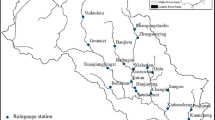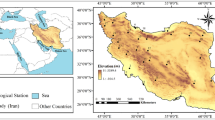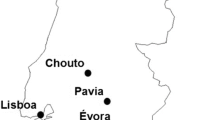Abstract
The widely used meteorological drought index, the Standardized Precipitation Index (SPI), basically assumes stationarity, but recent changes in the climate have led to a need to review this hypothesis. In this study, a new non-stationary SPI that considers not only the modified probability distribution parameter but also the return period under the non-stationary process was proposed. The results were evaluated for two severe drought cases during the last 10 years in South Korea. As a result, SPIs considered that the non-stationary hypothesis underestimated the drought severity than the stationary SPI despite that these past two droughts were recognized as significantly severe droughts. It may be caused by that the variances of summer and autumn precipitation become larger over time then it can make the probability distribution wider than before. This implies that drought expressions by statistical index such as SPI can be distorted by stationary assumption and cautious approach is needed when deciding drought level considering climate changes.












Similar content being viewed by others
References
Bedient PB, Huber WC (2001) Hydrology and floodplain analysis, 3rd edn. Prentice-Hall Publishing Co., Upper Saddle River
Caroni C, Panagoulia D (2016) Non-stationary modeling of extreme temperatures in a mountainous area of Greece. Revstat Stat J 14(2):217–228
Chanda K, Maity R (2015) Meteorological drought quantification with standardized precipitation anomaly index for the regions with strongly seasonal and periodic precipitation. J Hydrol Eng 20:06015007
Coles S (2001) An introduction to statistical modelling of extreme values. Springer, London
Jeong DI, Sushama L, Khaliq MN (2014) The role of temperature in drought projections over North America. Clim Chang 127:289–303
Katz RW, Parlange MB, Naveau P (2002) Statistics of extremes in hydrology. Adv Water Resour 25:1287–1304
Kim SU, Lee YS (2015) Flood frequency analysis considering probability distribution and return period under non-stationary condition. J Korea Water Resour Assoc 48:567–579 (In Korean)
Li JZ, Wang YX, Li SF, Hu R (2015) A nonstationary standardized precipitation index incorporating climate indices as covariates. J Geophys Res: Atmos 120:82–95
Mallya G, Tripathi S, Govindaraju RS (2015) Probabilistic drought classification using gamma mixture model. J Hydrol 526:116–126
McKee, T. B., N.J. Doesken, and J. Kleist, (1993). The relationship of drought frequency and duration to time scales. 8th Conf. On applied climatology. Anaheim, CA, American Meteorological Society, pp. 179–184
Milly PCD, Betancourt J, Falkenmark M, Hirsch RM, Kundzewicz ZW, Lettenmaier DP, Stouffer RJ (2008) Stationarity is dead: whither water management. Science 319:573–574
Mooley DA (1973) Gamma distribution probability model for Asian summer monsoon monthly rainfall. Mon Weather Rev 101:160–176
Núñez J, Rivera D, Oyarzún R, Arumí JL (2014) On the use of Standardized Drought Indices under decadal climate variability: critical assessment and drought policy implications. J Hydrol 517:458–470. https://doi.org/10.1016/j.jhydrol.2014.05.038
Olsen JR, Lambert JH, Haimes YY (1998) Risk of extreme events under nonstationary condition. Risk Anal 18:497–510
Panagoulia D, Economou P, Caroni C (2014) Stationary and nonstationary generalized extreme value modeling of extreme precipitation over a mountainous area under climate change. Environmetrics 25:29–43
Park J, Lim Y-J, Kim B-J, Sung JH (2017) Appraisal of drought characteristics of representative drought indexes using meteorological variables. KSCE J Civ Eng 22:2002–2009. https://doi.org/10.1007/s12205-017-1744-x
Pietzsch S, Bissolli P (2011) A modified drought index for WMO RA VI. Adv Sci Res 6:275–279
Rao AR, Hamed KH (2000) Flood frequency analysis. CRC Press, Boca Raton
Russo S, Dosio A, Sterl A, Barbosa P, Vogt J (2013) Projection of occurrence of extreme dry-wet years and seasons in Europe with stationary and nonstationary standardized precipitation indices. J Geophys Res: Atmos 118:7628–7639. https://doi.org/10.1002/jgrd.50571
Salas JD, Obeysekera J (2014) Revisiting the concepts of return period and risk for nonstationary hydrologic extreme events. J Hydrol Eng 19:554–556
Salvi K, Ghosh S (2016) Projections of extreme dry and wet spells in the 21st century India using stationary and non-stationary standardized precipitation indices. Climate Change 139:667–681
Shin HJ, Ahn HJ, Heo JH (2014) A study on the changes of return period considering nonstationarity of rainfall data. J Korea Water Res Assoc 47:447–457 (In Korean)
Stagge JH, Tallaksen LM, Gudmundsson L, Van Loon AF, Stahl K (2015) Candidate distribution for climatological drought indices (SPI and SPEI). Int J Climatol 35:4027–4040
Stedinger JR, Vogel RM, Foufoula-Georgiou E (1993) Chapter 18, frequency analysis of extreme events, handbook of hydrology, edited by Maidment, D.R. McGraw-Hill, New York
Sung JH, Chung ES (2014) Development of streamflow drought severity- and magnitude-duration-frequency curves using the threshold level method. Hydrol Earth Syst Sci 18(9):3341–3351
Sung JH, Chung ES, Kim Y, Lee B-R (2017a) Meteorological hazard assessment based on trends and abrupt changes in rainfall characteristics on the Korean peninsula. Theor Appl Climatol 127:305–326
Sung JH, Kim Y-O, Jeon JJ (2017b) Application of distribution-free nonstationary regional frequency analysis based on L-moments. Theor Appl Climatol. https://doi.org/10.1007/s00704-017-2249-8
Vicente-Serrano SM, Begueria S, Lopez-Moreno JI (2010) A multiscalar drought index sensitive to global warming: the standardized precipitation evapotranspiration index. J Clim 23:1696–1718
Vicente-Serrano SM, Garcia-Herrera R, Barriopedro D, Azorin-Molina C, Lopez-Moreno JI, Martin-Hernandez N, Tomas-Burguera M, Gimemo L, Nieto R (2016) The westerly index as complementary indicator of the North Atlantic oscillation in explaining drought variability across Europe. Clim Dyn 47:845–863. https://doi.org/10.1007/s00382-015-2875-8
Wang YX, Li JZ, Feng P, Hu R (2015a) A time-dependent drought index for non-stationary precipitation series. Water Resour Manag 29:5631–5647. https://doi.org/10.1007/s11269-015-1138-0
Wang W, Zhu Y, Xu R, Liu J (2015b) Drought severity change in China during 1961-2012 indicated by SPI and SPEI. Nat Hazards 75:2437–2451
Wu H, Svoboda MD, Hayes MJ, Wilhite DA, Wen F (2007) Appropriate application of the standardized precipitation index in arid locations and dry seasons. Int J Climatol 27:65–79
Xu K, Yang D, Yang H, Li Z, Qin Y, Shen Y (2015) Spatiotemporal variation of drought in China during 1961–2012: a climatic perspective. J Hydrol 526:253–264. https://doi.org/10.1016/j.jhydrol.2014.09.047
Acknowledgements
This work is supported by the “Research and Development for KMA Weather, Climate, and Earth system Services” of National Institute of Meteorological Sciences (NIMS).
Author information
Authors and Affiliations
Corresponding author
Rights and permissions
About this article
Cite this article
Park, J., Sung, J.H., Lim, YJ. et al. Introduction and application of non-stationary standardized precipitation index considering probability distribution function and return period. Theor Appl Climatol 136, 529–542 (2019). https://doi.org/10.1007/s00704-018-2500-y
Received:
Accepted:
Published:
Issue Date:
DOI: https://doi.org/10.1007/s00704-018-2500-y




